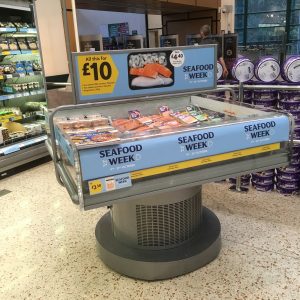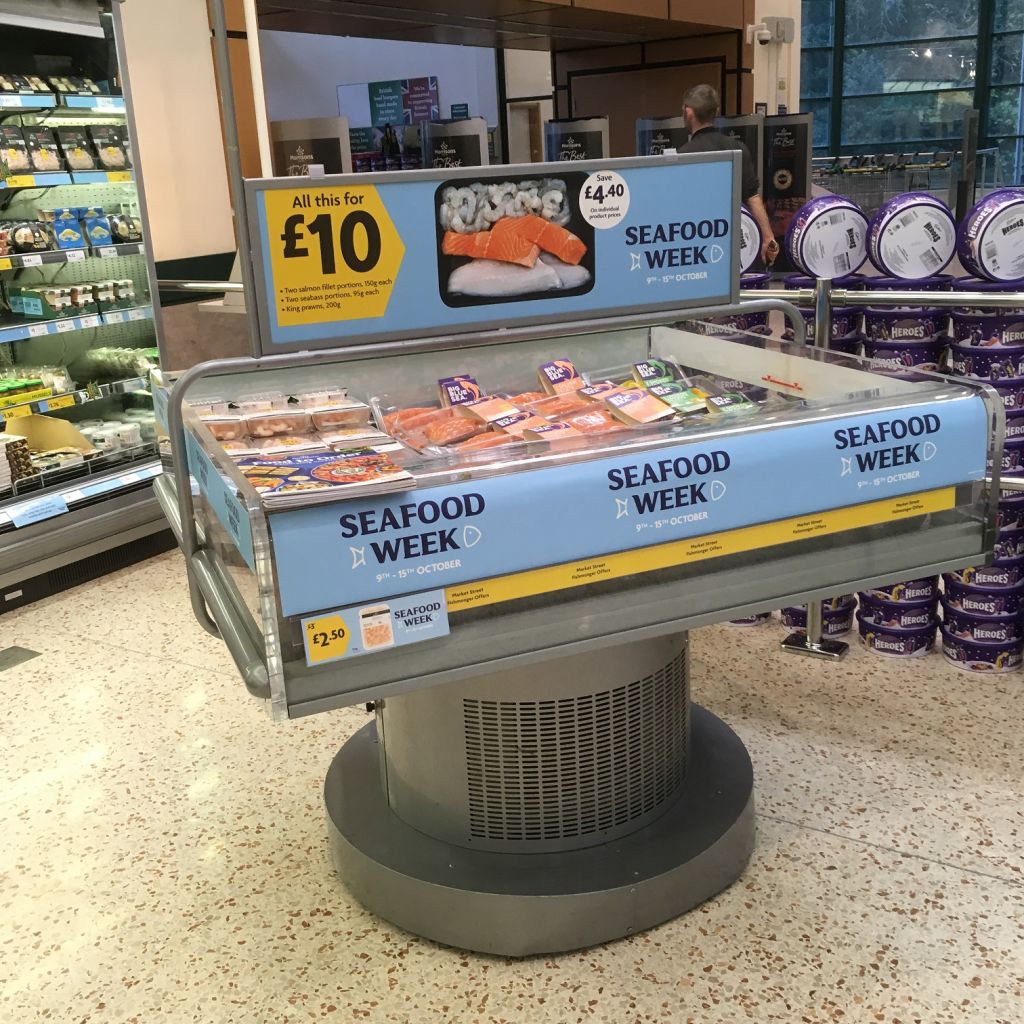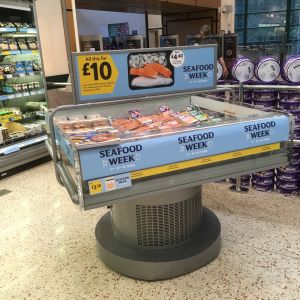Seafood Weak: This week our Twitter account has been full of Tweets about Seafood Week. This is not surprising given that most of those who we follow are linked to the seafood industry. We doubt whether the average consumer is exposed to the same level of coverage of the campaign and whether our industry involvement presents us with a distorted picture of Seafood Week? Certainly, our observations of the campaign in the retail sector suggest a very different picture, but not one much different from that of Seafood Week in recent years.
We, at Callander McDowell are not great fans of generic campaigns, especially when money is limiting. Whilst Twitter coverage may give the impression that the campaign was a great success, we are not sure. Of course, it really depends on how the campaign was being measured as how well it has done.
According to SeaFish, the aim of Seafood Week is to get more people to eat more fish, more often. The big question is whether the campaign has achieved this aim. We are not so sure. The problem is that Seafood Week covers all areas of seafood consumption making it difficult to isolate the various figures.
Our interest concerns how much fish and seafood consumers eat at home and thus how much they buy at retail. In 2015, the Coop reported a ten percent increase in sales during Seafood Week but our observations at the time suggested that the store group had increased the actual offering in store and we suspect that the increased sales reflected the increased offering. It could be asked why the Coop don’t stock this increased number of products all the time and our response would be that they get a better return by stocking something else instead. In 2016, there was no mention of increased sales as a consequence of Seafood Week, although a report to the SeaFish Board suggested overall sales of seafood had increased by 0.8% but it was unclear whether this was due to Seafood Week or not.
Instead, Seafish reported how Seafood Week had grown year on year by comparing figures from 2015 and 2016:
72% uplift in media figures from 76 million to 130 million
21% uplift in web traffic from 46,760 to 56,705
56% uplift in social media impressions for #seafoodweek from 53.8 million to 86 million
68% uplift in social media impression for Fish is the Dish
52% uplift in Twitter users from 4,457 to6.767
27% uplift in social media impressions from 11.5 million to 14.6 million.
Whilst the figures could be considered impressive, we are not sure how they relate to increased consumption of fish and seafood. We are equally unsure how they relate to the real consumers. They seem to be more about impressions to impress an industry that paid for the campaign rather than impressing consumers to eat more fish.
Whilst social media does play a part in the lives of many consumers it is sometimes unclear how it relates to their real lives. Thus, messages might be circulating in social media but are the same messages being repeated when consumers do their shopping?
This year, just three store groups appear to have engaged in some way with Seafood Week. These are Morrisons, Coop and Lidl.
Morrisons – the amount of involvement in the promotion appears to have varied from store to store. Whilst one store we visited had decorated a chiller unit with Seafood Week messages, most stores just had a couple of shelf labels such as one which states – ‘Cod is high in protein which contributes to the growth and maintenance of muscle mass’ or ‘Salmon is high in vitamin B12 which helps reduce tiredness’. We also saw a shelf label advertising a price promotion on cooked king prawns.

Coop – Seafood Week stickers were attached to a few fish and seafood products. The stickers were of two forms – a larger sticker stating Seafood Week or a smaller one that stated Seafood Week together with the date of the promotion and a web address. The number of stickers apparent varied between stores but consumers had to get up close to really see them.
Lidl – Seafood Week was mentioned in the weekly leaflet but in store, a handful of products carried the smaller Seafood Week sticker. Consumers would have to be very close to the packs to read the sticker.
As already mentioned, the aim of the campaign is to get more people to eat more fish more of the time. We would argue that consumers fall into one of two categories – those that already eat fish and those that don’t. It is already established that it is easier to get consumers who already eat fish to eat more than persuade those who don’t eat fish to start doing so. All the instore activity occurred around the fish shelves so would only be noticed by those who already eat fish but we don’t see that the application of a sticker to a pack would encourage existing fish consumers to eat more. After all, it might be seafood week but it is also national curry week, national chocolate week, national egg week and on the 10th of October, it was World Porridge Day. In fact, it is some food week almost every week of the year. A national Seafood Week campaign is not unique and just another part of efforts which aims to attract consumer interest. For example, Marks & Spencer preferred to focus on National Curry Week rather than Seafood Week, which perhaps is a more accurate reflection of British tastes.
We know it is easy to be critical of such generic campaigns but we firmly believe that attempts to convince consumers to eat fish should be highly specific about their aims and who they target. The real problem is that every year that goes by is another year that consumers are further divorced from this important food. Fish is the Dish have emailed that this year’s Seafood Week campaign is off the scale. We very much hope that this includes a clear indication of increased consumption rather than social media activity.
Blowing in the wind: It’s not only seafood consumption in the UK that is under threat, Kyst.no report that consumption in Norway may have plunged by 28% this year. Nordea Markets have issued a new report ‘Winds of Change’ that looks at salmon prices in future and in which they estimate that local consumption may have fallen much more than the 19% estimated by the Norwegian Seafood Council earlier this year. Data from Norges Gruppen suggest that retail sales may have fallen by 28%.
The Norwegian Seafood Council have previously indicated that consumption may be falling for several reasons including price, visibility and availability. In addition, NSC say that there is a generational effect in which older consumers are more likely to eat fish than those who are younger. Nordea say that prices are now on the way down and this should stimulate consumption.
Regular readers of reLAKSation will know that we have argued for many years that there is a long-term decline of fish consumption in many developed countries but at the same time, high salmon prices over the past few years have impacted on consumption especially in the traditional markets for salmon.
Fluctuating prices are a major issue when it comes to consumption. It is too simplistic to suggest that consumption will increase once prices fall because there is no guarantee that consumers who deserted fish when prices were high will return once fish becomes more affordable. These short-term losses in consumers can easily be transferred into the long-term with consumers remaining with their alternative meal choices rather bothering to seek out fish.
One of the underlying problems is that the salmon industry has become too short-term focussed and this is largely due to the increased willingness for fish companies to be listed on the stock market. Investors are often looking for short-term gains and may not be interested in the long haul. High prices translate into big dividends but as we have seen, this comes at the price of the consumer and reduced consumption.
If new markets, such as China, are unwilling to buy in to high priced imports then increased supply in the traditional markets will force down prices and margins. As in 1989, high costs will cripple the industry and we may see the start of a new phase of industry development.
Many years ago, we described the changes of 1989 as an industry move from production-led to one which is market-led. Could we now see a return to the market-led scenario from one which has until now become much more price-led, than production-led.
Salmon farming needs consumers to buy fish. If we forget the consumer the future industry may well be blowing in the wind.
Seize the day: The Herald and Sunday Herald newspapers have recently been at the forefront of negative messaging about the Scottish salmon industry. They have pounced on every Freedom of Information request from the anti-farming lobby and been ready to publish sensationalised stories that whilst may be based on truth are often taken out of context and may not be truly representative of the salmon industry of today.
It was therefore heartening to read an analysis from the Herald’s business correspondent this week suggesting that the salmon industry must leap over red tape to take advantage of export markets, especially in North America. This follows comments that the complex way that the industry is currently regulated must change in order to meet growing demand from overseas. It is not suggested that the regulations must be changed but rather that the process should be streamlined especially in relation to the number of different organisations involved.
The message from the Herald is that the industry must seize the opportunity to make salmon an even more important dish sent off into the world from Scottish shores. This is a refreshing view expressed from within the media.
Categorised: The Perth Courier reports that an angling club boss has accused the Scottish Government of ‘an assault on field sports’ after it proposed to tighten up the conservation limits on their local river for the coming year. The River Earn will become a category 3 river in 2018 meaning a 100% catch and release policy will be imposed.
This is not the first time the River Earn has been classified as a category 3 river as it was classed as such in 2016.It was reclassified as a category 2 river last year, which allowed anglers to kill some of the fish they caught. Clearly, such killing has impacted on the conservation status of the river meaning that the stocks are again in poor health.
The River Earn is not unique. The Scottish Government plans to increase the number of category 3 river by 68% to 123 rivers in total. The number of category 1 rivers will be reduced by more than half to just 21.
The increase in the number of category 3 rivers is perhaps not surprising. The number of returning fish has fallen significantly in recent years. During the 1980’s 20-25% of migrating smolts returned to their native river to breed. For some years, this figure is said to be just 5%. However, if the rate of return has been falling since the 1980’s then could it be that even a 5% return is now optimistic? The Scottish Government is clearly strengthening the conservation limits to help protect wild stocks for the future but we, at Callander McDowelll would argue that the new proposals do not go far enough. Surely, if there are concerns about the state of wild stocks, the sensible approach would be to classify all rivers in Scotland as category three so that salmon angling becomes mandatory catch and release. This should be imposed for a minimum of three years before being subject to review.
We know that there will be an outcry but if stocks aren’t protected now, there may be no fish left for anglers in years to come. Salmon & Trout Conservation claim to be a conservation organisation so it is difficult to understand why they are not already taking the lead on the imposition of stricter conservation limits (unless their recent name change was only a cynical attempt to deflect attention away from their own activities).
Comrie Angling Club are worried by the reclassification because they say that they have already seen a decline in membership by 20% when the river was last classified as category 3. They think that a return to category 3 might be the end for the club. We cannot see why. The change in classification does not prevent anglers from spending a day out on the river nor stop them from catching fish. What it does do is prevent them from killing any fish or allow them one for the pot. Millions of anglers fishing for other species of fish happily return every fish they catch without question. In fact, the outcry they made was when people from Eastern Europe started to kill fish to eat. Why shouldn’t salmon anglers also catch fish for the enjoyment rather than for the pot?
Local MSP, Liz Smith told the Courier that reclassification of the River Earn could result in a significant blow to the economy. She also said that local anglers are tired of the constant battle to maintain normal fishing rights on the river, yet clearly times are not normal so change must happen.
The River Earn is part of an east coast river system and therefore these changes do not have anything to do with the west coast salmon farming industry but we expect that when the new conservation limits are announcement, Salmon & Trout Conservation Scotland will issue a press release claiming that salmon farming is to blame for the increased number of category 3 rivers. As we all know, salmon farming is to blame for everything and anything so why not the new category 3 status of many Scottish rivers too.


